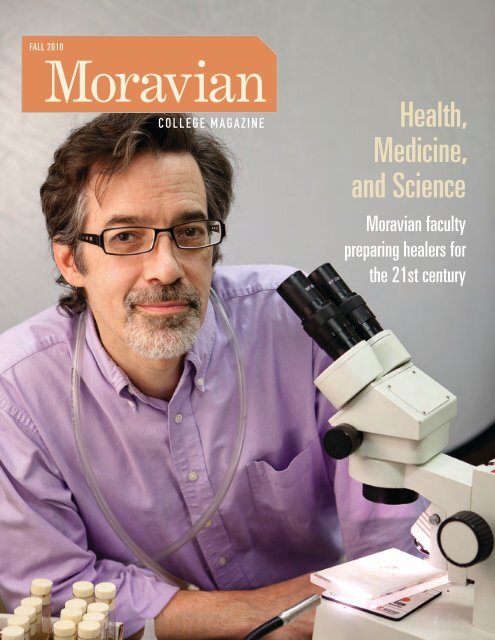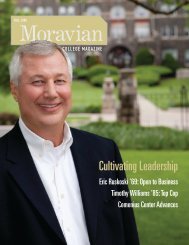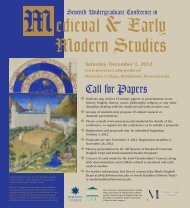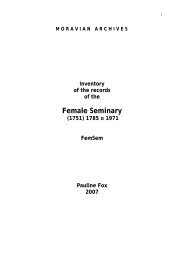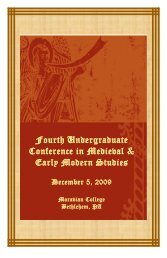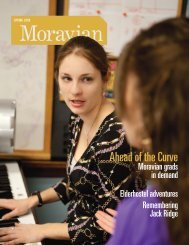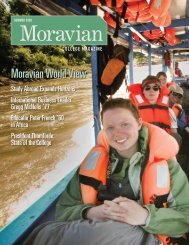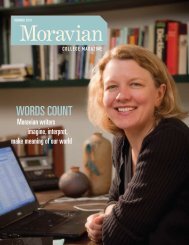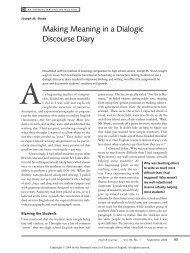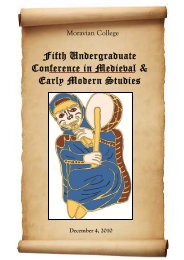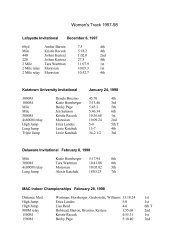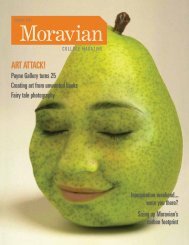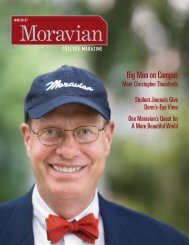Health, Medicine, and Science - Moravian College
Health, Medicine, and Science - Moravian College
Health, Medicine, and Science - Moravian College
Create successful ePaper yourself
Turn your PDF publications into a flip-book with our unique Google optimized e-Paper software.
FALL 2010<br />
<strong>Moravian</strong><br />
<strong>Health</strong>,<br />
<strong>Medicine</strong>,<br />
<strong>and</strong> <strong>Science</strong><br />
<strong>Moravian</strong> faculty<br />
preparing healers for<br />
the 21st century
<strong>Moravian</strong>
2 Prelude: This Is the Time<br />
By Frank Aless<strong>and</strong>ra ’88<br />
10 Going the Distance<br />
Myron Genel, M.D ’57 deftly navigates the<br />
intersection of medical research, clinical<br />
practice, <strong>and</strong> public policy.<br />
14 Anatomy of a Breakthrough<br />
During a recent visit, Nobel-prize winner Peter<br />
Agre spoke about his discovery of aquaporins<br />
<strong>and</strong> his life in medical science.<br />
16 Comfortable in Genes<br />
Chris Jones, associate professor of biological<br />
sciences, starts students on a research<br />
trail that could one day lead to a cure for<br />
Alzheimer’s disease.<br />
18 Virtual Fitness<br />
fall<br />
2010<br />
Thinking outside the box has helped Marc<br />
Thompson ’87 <strong>and</strong> his clients succeed.<br />
04 Out & About<br />
20 Alumni News<br />
22 Greyhound News<br />
23 Transitions<br />
24 Orbis Pictus: La Vita Barocco<br />
The delicious art of Marissa Sharon ’07<br />
See www.moravian.edu/magazine/extra for more from<br />
this issue.<br />
<strong>Moravian</strong> <strong>College</strong> Magazine : editor, Victoria Bingham;<br />
sports editor, Mark J. Fleming; web manager, Christie Jacobsen ’00;<br />
director of publications, Susan Overath Woolley;<br />
director of public relations <strong>and</strong> marketing, Michael P. Wilson.<br />
Creative Direction: Jane Firor & Associates.<br />
Alumni Relations: director, Marsha Stiles, M.B.A. ’99;<br />
assistant director, Patricia Murray Hanna ’82.<br />
Copyright 2010 by <strong>Moravian</strong> <strong>College</strong>. Photographs <strong>and</strong> artwork copyright<br />
by their respective creators or by <strong>Moravian</strong> <strong>College</strong>. All rights reserved.<br />
No portion of this publication may be reused or republished in any form<br />
without express written permission.<br />
Cover: <strong>Moravian</strong> science faculty members prepare students for<br />
careers in medicine <strong>and</strong> science, using a h<strong>and</strong>s-on approach to<br />
research, inside photo <strong>and</strong> by outside John Kish the IV classroom. Biology professor<br />
Christopher Jones’ research focuses on genetics <strong>and</strong> its<br />
relationship to Alzheimer’s disease.<br />
Photo by John Kish IV
p r e l u d e Stories from the <strong>Moravian</strong> community<br />
><br />
Photo by john kish iv<br />
2 MORAVIAN COLLEGE MAGAZINE FALL 2010
This Is the Time<br />
By Frank Aless<strong>and</strong>ra ’88<br />
Excerpted from The Six: A Story about Boys, Laughter, <strong>and</strong> a<br />
Lifelong Friendship, Frank Aless<strong>and</strong>ra’s new memoir about the<br />
30-year friendship between six friends growing up together in the<br />
New Jersey suburbs in the 1980s.<br />
Fall 1989. The next day, Rob <strong>and</strong> I were up by 10 a.m., <strong>and</strong><br />
after an uneventful breakfast in the hotel restaurant, we drove to<br />
the stadium, arriving before noon. I was excited to be in Steeler<br />
country yet also disappointed about the previous evening. I had<br />
to accept the fact that there would be no more new knee-slapping<br />
stories for “the six” to tell.<br />
As we watched the Steelers <strong>and</strong> Chiefs in their pre-game<br />
warm-ups, I thought about how appropriate it was that on this<br />
day, Rob <strong>and</strong> I were nothing more than spectators. I thought back<br />
to our high school football days <strong>and</strong> how I still had dreams of<br />
playing just one more season. But then I’d always wake up.<br />
The reality was that Rob <strong>and</strong> I were in the st<strong>and</strong>s that day <strong>and</strong><br />
not on the field. There would be no stories made of Barry punting,<br />
Tommy playing with a bad knee, or the seniors rallying to bring<br />
Chris back for the final game. Rob <strong>and</strong> I were on the outside looking<br />
in. We weren’t stirring up trouble, we weren’t creating a buzz,<br />
we weren’t drawing attention to ourselves, <strong>and</strong> we weren’t making<br />
memories. One day, I’d look back at this trip to Pittsburgh <strong>and</strong><br />
recall who won the game, but quite honestly, there’d be nothing<br />
more to remember, I thought. If anything, this weekend would go<br />
down as the story that never happened.<br />
The Steelers won a tight one, but as happy as I was with my<br />
team’s victory, part of me wasn’t feeling especially joyful. All that<br />
was left was the long ride home. The ’80s were ending, <strong>and</strong> so<br />
were all the extraordinary times with my friends. We’d be heading<br />
into the ’90s <strong>and</strong> things would be different.<br />
As I started the car, I thought about how I needed to be at the<br />
office early the next morning, <strong>and</strong> Rob mentioned that Deborah<br />
would be coming by his house for a late-night visit. Such anticipation<br />
of our return home gave me a clear preview of what would be<br />
ahead in this new decade. We were heading to a day when being<br />
with one another would no longer be the focal point of our lives.<br />
____________<br />
We needed to make a bathroom stop, so I got off of the turnpike<br />
<strong>and</strong> found a pizza place in a strip mall. As I waited for Rob<br />
in the dining area, I sat in a booth <strong>and</strong> stared aimlessly at the big<br />
refrigerator of sodas with the Pepsi logo on top.<br />
My daze was interrupted by the sounds of two couples at a<br />
nearby table. One of the women was carrying a toddler who was<br />
no more than two years old. She propped the child up in a high<br />
chair at the end of the booth <strong>and</strong> gave him a small toy. One of the<br />
men passed around the menus <strong>and</strong> the four talked about the pasta<br />
specials. I couldn’t help but overhear their conversations. They<br />
spoke about the cooling weather, the fat content of mozzarella,<br />
<strong>and</strong> the pumpkin costume the child would wear for Halloween.<br />
I was comforted by this rather touching, low-key scene. These<br />
friends seemed to really enjoy one another’s company, <strong>and</strong> there<br />
was nothing absurd or outrageous about it. There was no bar<br />
scene, no bathroom humor, no Shore house, <strong>and</strong> no women of the<br />
Valley. And although there was no knee-slapping, there was, in<br />
fact, laughing. They were happy <strong>and</strong> they were making memories.<br />
Billy Joel’s “This Is the Time” started to play through the<br />
speaker above me. I must have heard that song a thous<strong>and</strong> times,<br />
but this was the first time I really listened, it seemed. I thought<br />
about the past 10 years of my life.<br />
This is the time to remember<br />
’cause it will not last forever.<br />
These are the days to hold onto<br />
’cause we won’t although we’ll want to.<br />
This is the time,<br />
but time is going to change.<br />
I know we’ve got to move somehow,<br />
but I don’t want to lose you now.<br />
Yes, the guys <strong>and</strong> I were moving on, <strong>and</strong> that was okay.<br />
Perhaps we would no longer produce stories that were wild or<br />
outrageous, but maybe we were capable of creating memories of a<br />
different kind. W<br />
For more than 20 years, Frank Aless<strong>and</strong>ra ’88 (top) has relied on an annual get-together<br />
with five childhood buddies to soothe the stresses of adult life. Inspired to share their<br />
stories of youth <strong>and</strong> innocence, Aless<strong>and</strong>ra (a financial analyst by trade) uncovered a passion<br />
for writing. He graduated with honors in business accounting from <strong>Moravian</strong> <strong>College</strong><br />
<strong>and</strong> received an M.B.A. with honors from Lehigh University. He now lives in Flemington,<br />
New Jersey, <strong>and</strong> has two teenage daughters. Photo, p. 2: A group of 2010 students make<br />
memories, sharing stories between classes on a pathway above the HILL, Hurd campus.<br />
FALL 2010 MORAVIAN COLLEGE MAGAZINE 3
out&a b o u t<br />
Fulmers Bequeath Major Gift<br />
to Support the <strong>Science</strong>s<br />
A generous gift by<br />
Harlan Fulmer, M.D.<br />
‘43 <strong>and</strong> his wife<br />
M. Eleanor (Kern)<br />
Fulmer will benefit<br />
<strong>Moravian</strong> students for<br />
generations to come.<br />
<strong>Moravian</strong> <strong>College</strong> has learned that it will<br />
be the recipient of a major gift from the<br />
estate of Harlan Fulmer, M.D. ’43, who<br />
passed away September 2, 2010, <strong>and</strong> his<br />
wife M. Eleanor (Kern) Fulmer, who predeceased<br />
him. The $5 million bequest is the<br />
largest that the <strong>College</strong> has ever received.<br />
Half of the bequest will be added to<br />
the Harlans’ existing endowed scholarship<br />
for pre-med, pre-dental, <strong>and</strong> nursing<br />
students. The remainder will be used to<br />
support the construction of the new Hall of <strong>Science</strong>. After graduating<br />
from <strong>Moravian</strong>, Dr. Fulmer completed his graduate medical<br />
studies at the University of Pennsylvania School of <strong>Medicine</strong> in<br />
Philadelphia, then enjoyed a long career as a pathologist in Fresno,<br />
California.<br />
“The <strong>College</strong> is most grateful to Dr. Fulmer for his remarkable<br />
generosity,” said President Christopher Thomforde. “A gift like<br />
his will directly benefit the lives of our students for generations to<br />
come. Planned gifts, like Dr. Fulmer’s, are a great way to support<br />
the <strong>Moravian</strong> mission <strong>and</strong> are of benefit to the donor as well. We<br />
continue to be able live out our mission in vital <strong>and</strong> creative ways<br />
to the benefit of our students, thanks to the generosity of our<br />
alumni <strong>and</strong> friends.”<br />
photo courtesy of Rev. Ken Fulmer ‘45<br />
HAPPENING . . .<br />
December 3-5,<br />
December 10-12<br />
Christmas Vespers Services<br />
Central <strong>Moravian</strong> Church<br />
8:00 P.M. Fridays <strong>and</strong> Saturdays, 5:00<br />
P.M. Sundays • A <strong>Moravian</strong> holiday<br />
tradition. Advance tickets required.<br />
for more details, see www.moravian.edu/news, or call 610 861-1300<br />
January 27-March 6<br />
Emilio Dilorio: The Figure–Drawings,<br />
Paintings, <strong>and</strong> Sculpture<br />
Payne Gallery<br />
11:00 A.M.-4:00 P.M., Tuesday-Sunday • Forty<br />
works reveal this Lehigh Valley physician’s<br />
mastery of form <strong>and</strong> technique.<br />
4 MORAVIAN COLLEGE MAGAZINE FALL 2010
Performing Political Theory<br />
photos by khristina haddad<br />
Students in Professor Khristina Haddad’s political<br />
science class learn political theory through action.<br />
February 24-27<br />
Student Cabaret<br />
Arena theatre<br />
8:00 P.M. Thursday, Friday, <strong>and</strong> Saturday;<br />
2:00 P.M. Sunday • An evening of singing,<br />
dancing, <strong>and</strong> laughter! Student<br />
initiated, directed, acted, designed, <strong>and</strong><br />
produced.<br />
A good professor is a bit like the producerdirector<br />
of a successful stage play—breathing<br />
life, meaning, <strong>and</strong> relevance into what<br />
otherwise would be empty words expressing<br />
unfamiliar ideas. Inspired by Gordon<br />
Kampe’s environmental opera Zivilcourage,<br />
Khristina Haddad, associate professor<br />
of political science, recently produced a<br />
new take on Political <strong>Science</strong> 120: Introduction<br />
to Political Thinking. Through the<br />
h<strong>and</strong>s-on process of staging <strong>and</strong> acting<br />
dramatic pieces, students experience political<br />
theory in action.<br />
Professor Haddad saw<br />
Zivilcourage (“moral courage,”<br />
about political thinker<br />
Hannah Arendt) performed<br />
in Germany in the summer<br />
of 2009. “This opera made<br />
political theory come alive for<br />
me <strong>and</strong> others in the audience.<br />
I thought, ‘how can I teach<br />
political science differently’<br />
It completely embodied the<br />
experience of moral courage—<br />
the courage of the unarmed<br />
civilian, associated with a high<br />
level of political engagement.”<br />
Haddad wanted her students to experience<br />
that kind of engagement with the<br />
world—not an easy task in a controlled<br />
classroom setting. The class’s first assignment:<br />
to mess up the classroom. The lesson<br />
was linked to a text by political theorist<br />
Michel Foucault, Discipline <strong>and</strong> Punish,<br />
about the disciplinary power of social<br />
institutions.<br />
“It was very difficult for my students to<br />
do,” said Professor Haddad, who received<br />
the 2008 Lindback Foundation Award<br />
for distinguished teaching. “I asked them<br />
to try again, <strong>and</strong> told them they would<br />
underst<strong>and</strong> the meaning by the end of<br />
the semester: School is an institution that<br />
heavily socializes behavior.”<br />
Later assignments involved staging<br />
plays that interpreted the political thinking<br />
of Shakespeare’s Richard III, Machiavelli’s<br />
The Prince, <strong>and</strong> the Platonic dialogue<br />
The Apology. Nicole Tabor, an assistant<br />
professor of English who teaches courses<br />
on dramatic literature, provided valuable<br />
input regarding theater pedagogy.<br />
Like Zivilcourage, the class’s performances<br />
were not limited to one location or<br />
space, but moved around campus.<br />
“Zivilcourage begins in the courtyard<br />
of a church <strong>and</strong> ends in a public<br />
square where performers can no longer be<br />
distinguished from audience members,”<br />
explained Haddad. “This conveys the role<br />
of a specific space in shaping political perspective.<br />
By moving to different settings,<br />
performers <strong>and</strong> audience see <strong>and</strong> hear from<br />
a variety of perspectives.” Each exercise<br />
reinforced the message that people are<br />
not automatically fit for political action;<br />
involvement takes practice.<br />
“It was a really neat class!” said Steven<br />
Feldman ’11, a work-study student who<br />
assisted with class planning, syllabus<br />
design, <strong>and</strong> coaching. Now an intern at<br />
the U.S. Embassy to the Holy See, Feldman<br />
says the political discussions feel very<br />
familiar: “I was helping run a rather large<br />
interfaith conference yesterday, <strong>and</strong> everyone<br />
was talking about framing issues.”<br />
FALL 2010 MORAVIAN COLLEGE MAGAZINE 5
out&ab o u t<br />
<strong>Moravian</strong> Scholars Meet in Bethlehem<br />
Photos by john kish iv<br />
<strong>Moravian</strong> scholars from around the world gathered in the historic<br />
Gemeinhaus <strong>and</strong> Peter Hall October 14-17 for the third biennial<br />
Bethlehem Conference on <strong>Moravian</strong> Music <strong>and</strong> History. “<strong>Moravian</strong><br />
history has been a cutting edge topic among colonial historians in<br />
recent years,” said Heikki Lempa, conference co-organizer <strong>and</strong> chair<br />
of the <strong>Moravian</strong> History Department. “Because of the extensive<br />
records kept by the <strong>Moravian</strong>s, it is one of the best venues for exploring<br />
native American history.” The <strong>Moravian</strong>s also are of great interest<br />
because of the Church’s controversial role in religious history, <strong>and</strong><br />
because of the important <strong>and</strong> exceptional roles women, Africans, <strong>and</strong><br />
native Americans played within the community, he added.<br />
A musical highlight was a cittern, harp, <strong>and</strong> voice performance by<br />
Duo March<strong>and</strong>, which played <strong>Moravian</strong><br />
pieces first published in 1761.<br />
Andrew Rutherford constructed the<br />
cittern, which is an exact replica of the<br />
only known existing eighteenth-century<br />
cittern, said Hilde Binford, conference<br />
co-organizer <strong>and</strong> associate professor of<br />
music. The conference was co-sponsored<br />
by <strong>Moravian</strong> <strong>College</strong>, the <strong>Moravian</strong><br />
Archives, <strong>and</strong> the <strong>Moravian</strong> Music<br />
Foundation.<br />
Duo March<strong>and</strong> (Andrew Rutherford, cittern, <strong>and</strong> Marcia Young, voice<br />
<strong>and</strong> harp) filled Peter Hall with the sounds of eighteenth-century<br />
<strong>Moravian</strong> music during the recent <strong>Moravian</strong> conference. Left: History<br />
professor Heikki Lempa, conference co-organizer, participated in a<br />
panel discussion on early <strong>Moravian</strong> education.<br />
Enlisting Citizen Scientists<br />
Diane Husic, chair <strong>and</strong> professor of biological sciences, has been selected a 2010 TogetherGreen Fellow.<br />
She is one of just 40 conservation professionals in the nation to receive the award, which is supported by<br />
an alliance between Audubon <strong>and</strong> Toyota. As a Fellow, she will receive training in conservation planning,<br />
the chance to work <strong>and</strong> share best practices with other conservation professionals, <strong>and</strong> assistance<br />
with project outreach <strong>and</strong> evaluation. Each Fellow also receives $10,000 toward a community-focused<br />
conservation project. Dr. Husic’s project involves phenology, the study of the relationship between natural<br />
seasonal events <strong>and</strong> the environment. Working with local environmental educators, she has begun to build<br />
a regional network of “citizen scientists” who will monitor key ecological events <strong>and</strong> species. <strong>Moravian</strong><br />
students will help design the programming, collect data, <strong>and</strong> “mine” historical data related to phenology.<br />
“It is important to connect people in meaningful ways to environmental problems,” she said. “This project will get people outdoors observing<br />
nature!” The data will be useful to scientists as the state begins planning for climate change adaptation, she added.<br />
Photo by john kish iv<br />
6 MORAVIAN COLLEGE MAGAZINE FALL 2010
Fall Convocation Brings<br />
CHINA IN FOCUS<br />
photos by john kish iv<br />
China, one of the world’s oldest <strong>and</strong> most fascinating cultures <strong>and</strong> its<br />
second largest economy, will be on the minds of <strong>Moravian</strong>s throughout<br />
the 2010-11 academic year. For CHINA IN FOCUS, students,<br />
faculty, staff, <strong>and</strong> alumni will consider <strong>and</strong> experience China through<br />
lectures <strong>and</strong> readings; coursework here <strong>and</strong> abroad; art, music, film,<br />
<strong>and</strong> dance; Chinese cuisine <strong>and</strong> tai chi.<br />
IN FOCUS is a new initiative that seeks to build a more active<br />
learning community by exploring an important topic over the course<br />
of a full year. “We’re very excited,” said Dr. Kathy Thomforde, co-chair<br />
of the Committee for Thematic Programming (CTAP). “We wanted to<br />
encourage cooperation <strong>and</strong> linkages across our campus community,<br />
<strong>and</strong> it’s happening.”<br />
The idea for a year of thematic programming emerged over dinner<br />
table discussions with small groups of faculty members at the home of<br />
President Christopher <strong>and</strong> Kathy Thomforde. Faculty members said<br />
they wished students had more opportunities to study <strong>and</strong> underst<strong>and</strong><br />
a complex issue from a variety of perspectives. By focusing on a single<br />
issue throughout the year, CTAP hopes to create more interdisciplinary<br />
connections <strong>and</strong> boost attendance at events.<br />
Fall Convocation, September 23, marked the official kick-off of<br />
CHINA IN FOCUS with a lecture by Cohen keynote speaker Rob<br />
Gifford, NPR foreign correspondent <strong>and</strong> author of China Road.<br />
President Thomforde <strong>and</strong> faculty members donned academic attire for Fall<br />
Convocation, a new tradition to celebrate the start of the academic year. Cohen<br />
keynote speaker Rob Gifford spoke about China, launching IN FOCUS, a year of<br />
thematic programming.<br />
MORAVIANBOOKSHELF<br />
n Wayward, a new book of poems by James P.<br />
West, professor <strong>and</strong> chair or economics, distills<br />
pivotal events (like September 11, 2001) <strong>and</strong><br />
big ideas (the oneness of human life) into<br />
simple statements deep with meaning. “Like<br />
economics graphs, my poetry is designed<br />
to be concise but meaningful,” said West.<br />
Available at the <strong>Moravian</strong> <strong>College</strong> Book<br />
Store, the <strong>Moravian</strong> Book Shop, <strong>and</strong> at<br />
www.jamespwest.com.<br />
n The Book of Amos<br />
in Emergent Judah by Jason Radine,<br />
assistant professor of religion, challenges<br />
traditional scholarly assumptions about<br />
the biblical book. Amos is not a work<br />
of prophecy, he asserts, “but rather a<br />
religio-political document that explains the withdrawal of<br />
divine favor from the northern kingdom of Israel.”<br />
Radine believes the book of Amos was written<br />
in stages, the earliest about 700 B.C.—60 years<br />
later than conventionally believed. Available<br />
in academic libraries throughout the U.S. <strong>and</strong><br />
Europe.<br />
n Stranger Here Below, a new novel by Joyce<br />
Hinnefeld, associate professor of English, is the<br />
story of three generations of women connected<br />
through two communities: the Shaker site of<br />
Pleasant Hill <strong>and</strong> Berea <strong>College</strong>. At the center<br />
of the book is the friendship between two girls—one<br />
white, one black—who are Berea roommates in 1961, a<br />
time of upheaval. For a schedule of book readings <strong>and</strong><br />
signings, visit www.strangerherebelow.com/events.html.<br />
FALL 2010 MORAVIAN COLLEGE MAGAZINE 7
out&ab o u t<br />
New members of the <strong>Moravian</strong> <strong>College</strong> Board of<br />
Trustees (above) gathered in the HUB before a<br />
dinner of the entire group during meetings held<br />
in October. From left: Wilton Grannum, Honnie<br />
Spencer ’90, Kelly Denton-Borhaug, Corey Koenig<br />
’11, Paul Sittenfeld, Chris Ohmacht, Betsy Miller,<br />
Brian Corvino ’02, <strong>and</strong> Brittany Beard ’12. Missing:<br />
C<strong>and</strong>y Barr Heimbach ’79.<br />
New on Board<br />
The <strong>Moravian</strong> <strong>College</strong> Board of Trustees<br />
met at the <strong>College</strong> in late October for<br />
several days of review <strong>and</strong> planning. The<br />
Board welcomed new members Brian<br />
Corvino ’02, Newtown, Pa., partner PharmaStrat,<br />
Inc. <strong>and</strong> president of the alumni<br />
board; Kelly Denton-Borhaug, Coopersburg,<br />
Pa., associate professor of religion<br />
at <strong>Moravian</strong> <strong>College</strong>; Wilton Grannum,<br />
Brooklyn, N.Y., president of the Board of<br />
Trustees for John Hus <strong>Moravian</strong> Church;<br />
C<strong>and</strong>y Barr Heimbach ’79, Bethlehem, Pa.,<br />
attorney <strong>and</strong> vice president at Marshall,<br />
Dennehy, Warner, Coleman & Goggin;<br />
Betsy Miller ’85, Bethlehem, Pa., president<br />
photo by john kish iv<br />
of the Provincial Elders Conference Northern<br />
Province, <strong>and</strong> a <strong>Moravian</strong> Theological<br />
Seminary trustee; Christopher Ohmacht<br />
’88, Franklin Lakes, N.J., president for<br />
global distribution at Victory Capital Management;<br />
Paul Sittenfeld, Cincinnati, Ohio,<br />
managing director for Robert W. Baird &<br />
Co. <strong>and</strong> a <strong>Moravian</strong> Theological Seminary<br />
trustee; Honnie Spencer ’90, Mooresville,<br />
N.C., physician; Brittany Beard ’12, Lebanon,<br />
Pa., a student majoring in psychology;<br />
<strong>and</strong> Corey Koenig ’11, Springtown, Pa., a<br />
student majoring in business management.<br />
During an open “Meet the Trustees”<br />
forum, trustees fielded questions on topics<br />
ranging from career services to enrollment<br />
to campus parking. Alumni figured prominently<br />
in the discussion, which included<br />
input from faculty <strong>and</strong> staff members. “We<br />
have an active alumni association with new<br />
chapters, but we need the resources to coordinate<br />
<strong>and</strong> augment their involvement to<br />
benefit current students <strong>and</strong> the <strong>College</strong>,”<br />
said Rick Subber ’69, M.B.A. ’95, treasurer<br />
<strong>and</strong> past president of the alumni board.<br />
Alumni affinity groups, such as former<br />
members of the Amrhein Investment Club,<br />
already are offering valuable career advice,<br />
said trustee Michael Ellis ’72, but much<br />
more could be achieved if “all alumni<br />
would serve as <strong>Moravian</strong> <strong>College</strong> ambassadors,”<br />
reaching out not only to current<br />
students, but also to potential enrollees.<br />
PRESIDENT THOMFORDE SIGNS EXCHANGE AGREEMENT<br />
<strong>Moravian</strong> <strong>College</strong> <strong>and</strong> the Universite de Poitiers have agreed to establish<br />
a full exchange between the two institutions commencing<br />
Spring 2011. Students will be able to pursue a semester or an academic<br />
year of study as a visiting student. Course instruction will<br />
be offered in both French <strong>and</strong> English. The exchange will involve<br />
access to most academic departments, including political science,<br />
literature, music, art, economics <strong>and</strong> business, <strong>and</strong> French. Right:<br />
President Christopher Thomforde signs the agreement as Jean-<br />
Pierre Lal<strong>and</strong>e, <strong>Moravian</strong> professor of French <strong>and</strong> Latin, <strong>and</strong> Professor<br />
Andre Magord of the Universite de Poitiers, look on.<br />
photo by michael wilson<br />
8 MORAVIAN COLLEGE MAGAZINE FALL 2010
Frank Kuserk Honored for Mentoring<br />
For more than 30 years, Frank Kuserk, professor of<br />
biological sciences <strong>and</strong> director of the environmental<br />
studies program, has inspired <strong>Moravian</strong> <strong>College</strong> students<br />
to buckle down, reach higher, do more.<br />
In August, Kuserk’s impact was recognized nationally,<br />
when the Council on Undergraduate Research<br />
(CUR) honored him with its first Biology Mentor<br />
Award. “Being a mentor is not just about advising the<br />
best students, but about giving honest advice to all<br />
students so they have a chance to reach their potential,”<br />
he said.<br />
Kuserk is enthusiastic about the value of teaching<br />
through collaborative research with students. Under<br />
Dr. Kuserk’s guidance, students have published articles<br />
in scholarly journals <strong>and</strong> have presented their work at<br />
scientific meetings. Several students have received awards, such<br />
as the American Institute of Biological <strong>Science</strong>s National Undergraduate<br />
Research Award.<br />
“Dr. Kuserk’s lessons are not bound by classroom walls,” said<br />
Matt Share ’11, a biology major who monitored conditions in the<br />
Little Lehigh stream last summer, under Kuserk’s tutelage. “Sure,<br />
he’s taught me a lot about ecology, animal behavior, <strong>and</strong> Darwin—but<br />
he also has aided me in my quest for graduate school<br />
admission <strong>and</strong> has provided a few life lessons along the way, too.”<br />
photos by john kish iv<br />
Professor Frank Kuserk explains a stream<br />
biomonitoring technique to environmental science<br />
major Chiu Cheng ’09. Now a grad student at Florida<br />
State University, Cheng studies oceanography.<br />
Hillel Celebrates the Season<br />
photo by john kish iv<br />
The <strong>Moravian</strong> Hillel Society celebrated Sukkot September 23 by inviting<br />
the entire campus community to help build <strong>and</strong> decorate a Sukkah<br />
(a hut or temporary structure). Sukkot commemorates the experience<br />
of Israelites living in temporary structures during their exodus from<br />
slavery in Egypt. “It’s one of the most fun holidays,” said Gregg Steinman<br />
’12, president of the <strong>Moravian</strong> Hillel Society. “It represents the<br />
Israelites’ journey toward freedom, <strong>and</strong> celebrates the autumn harvest.”<br />
Hillel members <strong>and</strong> friends constructed the 8 x 12 foot structure<br />
over several hours then festooned it with paper garl<strong>and</strong>s, branches, <strong>and</strong><br />
artificial fruit <strong>and</strong> vegetables. A Sukkot ritual demonstration followed.<br />
“Fruit <strong>and</strong> natural materials are traditional Sukkot decorations,”<br />
said Hillel member Lillian Shad ’11. “They signify hospitality—the<br />
more you give, the more you receive.” Hillel plans other community<br />
activities, such as Hanukah <strong>and</strong> Purim celebrations, for the remainder<br />
of the academic year. Jason Radine, assistant professor of religion,<br />
advises Hillel.<br />
FALL 2010 MORAVIAN COLLEGE MAGAZINE 9
Photo by john kish iv<br />
10 MORAVIAN COLLEGE MAGAZINE FALL 2010
Going the Distance<br />
Myron Genel ’57, M.D. deftly navigates the intersection of medical<br />
research <strong>and</strong> public policy.<br />
Top of his game: Myron Genel, M.D. ’57, professor<br />
emeritus of pediatrics <strong>and</strong> senior research scientist<br />
at Yale University, is a consultant to the International<br />
Olympic Committee, public affairs director for three<br />
major pediatric societies, practicing physician, <strong>and</strong><br />
marathon runner.<br />
sex.” Myron (Mike) Genel,<br />
M.D., ’57, is an authority on<br />
“Athletic<br />
the subject. But as this professor<br />
emeritus of pediatrics <strong>and</strong> senior research<br />
scientist is quick to point out, “it’s not<br />
what you think it is.”<br />
For more than two decades, Dr. Genel<br />
has been near the center of the debate on<br />
gender identification in international athletic<br />
competition. He was widely quoted<br />
last year in the wake of controversy over<br />
South African runner Caster Semenya, who<br />
won the women’s 800-meter race at the<br />
2009 World Championships despite questions<br />
about her sex.<br />
Yet Genel’s involvement with the<br />
highly controversial issue is something of a<br />
fluke. Timing, happenstance, <strong>and</strong> personal<br />
relationships had a good deal to do with<br />
most of his career milestones, he insists:<br />
“So many of the things we end up doing<br />
are not conscious decisions but the result<br />
of a confluence of events—the things you<br />
thought you would do, you never end up<br />
doing, or you don’t do them quite the way<br />
you imagined you would.”<br />
The Upside of a Traffic Jam<br />
“Back in the mid-’80s, I was stuck in<br />
traffic, so I pulled out the JAMA [Journal<br />
of the American Medical Association] beside<br />
me <strong>and</strong> flipped through it. I said, ‘my<br />
God, look at that,’” recalls Genel.<br />
An article by Finnish geneticist Albert<br />
de la Chapelle pointed out problems<br />
with the way gender was being verified<br />
at the Olympic Games. The Buccal Smear<br />
chromosome test, which examines mouth<br />
cells for either XX or XY chromosomes,<br />
was often inaccurate <strong>and</strong> did not consider<br />
certain genetic anomalies.<br />
As a practicing pediatric endocrinologist<br />
<strong>and</strong> marathon runner, Genel was<br />
intrigued <strong>and</strong> immediately dictated a letter<br />
to the author. “Within a week, I got a reply<br />
telling me how frustrated he was because<br />
nobody would take action,” he says. “I<br />
wrote back <strong>and</strong> said maybe we ought to<br />
mobilize a professional society to start<br />
working on it.” Genel quickly enlisted the<br />
American Medical Association <strong>and</strong> other<br />
professional associations <strong>and</strong> got them<br />
to pass resolutions proposing changes<br />
to the International Olympic Committee<br />
procedures.<br />
When the IOC failed to act, the<br />
organization now known as the International<br />
Association of Athletics Federations<br />
convened a workshop to address the issues.<br />
The international interdisciplinary team<br />
eventually succeeded in eliminating gender<br />
verification in international athletic competition,<br />
including the 2000 Olympic Games.<br />
Genel continues to serve as a consultant<br />
to the IOC, <strong>and</strong> in January 2010 he was<br />
part of the panel that recommended treatment<br />
(not disqualification) of athletes with<br />
sexual development disorders.<br />
“The point we are making is where do<br />
you draw the line Athletes are drawn to<br />
compete because there are physical differences<br />
among people from birth. There is<br />
no such thing as a level playing field.”<br />
A Long <strong>and</strong> Winding Road<br />
Happenstance aside, Yale Medical<br />
School’s former associate dean for government<br />
<strong>and</strong> community affairs (1985-2004)<br />
clearly has a knack for navigating the<br />
interface of biomedical research, clinical<br />
endocrinology, <strong>and</strong> public policy.<br />
“In many respects, what I’ve done over<br />
FALL 2010 MORAVIAN COLLEGE MAGAZINE 11
Mike Genel ran the 1998 Key Bank Marathon in<br />
Burlington, Vt., one of seventeen he’s run; his<br />
personal best was 3 hours, 11 minutes, at the age<br />
of 50. He began running soon after he gave up<br />
smoking at the age of 43. “I had to do something<br />
to burn off the stored up energy,” he says.<br />
the last 30 years is a hybrid of medicine<br />
<strong>and</strong> public policy,” he says. “At <strong>Moravian</strong><br />
I committed to pre-med, but didn’t<br />
really think much about it. Even until my<br />
senior year, I considered applying to law<br />
school.” A stint as editor of the Comenian<br />
student newspaper <strong>and</strong> summer work for<br />
the Morning Call likely contributed to his<br />
interest in advocacy, he speculates.<br />
But Genel chose medicine, studying<br />
at the University of Pennsylvania School<br />
of <strong>Medicine</strong>, <strong>and</strong> later (for postdoctoral<br />
training) at Mount Sinai Hospital, Johns<br />
Hopkins Hospital, <strong>and</strong> the Children’s Hospital<br />
of Philadelphia.<br />
Besides being part of the team that succeeded<br />
in eliminating gender verification in<br />
international athletic competition, Myron<br />
Genel helped write the 1984 National<br />
Organ Transplant Act (NOTA), served<br />
on the National Children’s Study Federal<br />
Advisory Committee, <strong>and</strong> was a founder of<br />
the Connecticut Stem Cell Coalition.<br />
He first became involved with organ<br />
donation in 1982, when, as a Robert Wood<br />
Johnson <strong>Health</strong> Policy Fellow, he’d been<br />
assigned to work for a (then) relatively<br />
obscure Tennessee congressman named Al<br />
Gore. “As with all politicians, his staff was<br />
always looking for issues that would put<br />
him in the limelight,” Genel remembers.<br />
One day, the Congressman’s office received<br />
a telegram from a father in Memphis, requesting<br />
help obtaining a liver for his son.<br />
“They asked me if I could help find<br />
a liver for this child. My response was<br />
‘you’ve got to be kidding—what is Congress<br />
doing trying to find livers for kids’”<br />
Certain there had to be a better way to<br />
match organ donors with potential recipients,<br />
he convinced Gore’s staff to push for<br />
Congressional hearings on the issue. At the<br />
1983 hearings, “they brought in a telegenic<br />
woman whose son was at the Memphis<br />
children’s hospital, waiting for a liver<br />
transplant. Soon after she testified, a liver<br />
was found for him.”<br />
The dramatic turn of events made<br />
front page news, <strong>and</strong> “out of that positive<br />
publicity, we wrote the National Organ<br />
Transplant Act, which now governs the<br />
entire organ donation system in the U.S.”<br />
Follow Your Nose<br />
Genel hasn’t slowed his pace much in<br />
recent years. In October he attended an<br />
IOC meeting in Lausanne, Switzerl<strong>and</strong>,<br />
this time to consider the legal <strong>and</strong> philosophical<br />
aspects of the gender issue in elite<br />
sports. “We’ve been at this business of<br />
gender verification for 25 years <strong>and</strong> it still<br />
has not been totally resolved,” he says.<br />
He also continues to direct public affairs<br />
for three major pediatric societies, <strong>and</strong><br />
as a member of the Connecticut Stem Cell<br />
Research Advisory Committee, he helps<br />
oversee the distribution of $100 million in<br />
state funds to support stem cell research.<br />
His connection to the Connecticut<br />
Stem Cell Coalition can be traced to an<br />
earlier organization, CURE (Connecticut<br />
United for Research Excellence), which he<br />
helped launch <strong>and</strong> lead as its first president.<br />
The coalition of 70 health organizations<br />
aimed to promote public underst<strong>and</strong>ing<br />
of biomedical research. Genel’s<br />
youthful newspaper experience again<br />
proved valuable, as he recognized the need<br />
to package research news in a way that<br />
would garner publicity. “We discovered<br />
that putting our research advances in terms<br />
of economic potential <strong>and</strong> development<br />
got media attention.”<br />
Then, about seven years ago, Genel<br />
received a call from an acquaintance, Milt<br />
Wallack, whose gr<strong>and</strong>child had juvenile<br />
diabetes. Knowing that stem cell research<br />
offered hope, Wallack mentioned California’s<br />
large stem cell research program:<br />
“Could Connecticut do something like<br />
it” Genel advised him to get in touch<br />
with CURE. The coalition succeeded in<br />
convincing the State of Connecticut to pass<br />
legislation (Act 04-159) in 2005, establishing<br />
a fund for stem cell research along with<br />
a committee to oversee distribution.<br />
“By using CURE’s resources <strong>and</strong> representatives<br />
of various advocacy organizations<br />
who had their own networks, we were<br />
able to get the legislation passed <strong>and</strong> funded<br />
in 18 months,” Genel says. The state stem<br />
cell research initiatives were in response<br />
to a limitation in federal funding imposed<br />
by the Bush administration, he explains.<br />
California’s Proposition 71 was funded by<br />
12 MORAVIAN COLLEGE MAGAZINE FALL 2010
state bonds, but Connecticut’s stem cell<br />
research is a direct appropriation funded by<br />
a multistate settlement with major tobacco<br />
companies related to cigarette use.<br />
Connecticut was the first state to actually<br />
award funds for stem cell research. The<br />
seed money allowed Connecticut to establish<br />
stem cell research labs at Yale <strong>and</strong> the<br />
University of Connecticut—“infrastructure<br />
that will help us get major federal funding”<br />
for research that could one day lead<br />
to a cure for juvenile diabetes, Parkinson’s<br />
disease, spinal cord injuries, <strong>and</strong> more.<br />
“It all happened through coincidence<br />
<strong>and</strong> personal relationships,” says Genel. “If<br />
Milt Wallack had not contacted me about<br />
his gr<strong>and</strong>child, I would not have gotten<br />
into this . . . You have to follow your nose,<br />
wherever it takes you.”<br />
Through the years, Genel has balanced<br />
public service with teaching <strong>and</strong> patient<br />
care. “Teaching medical students <strong>and</strong> residents<br />
<strong>and</strong> caring for patients in the hospital<br />
<strong>and</strong> clinic are integral parts of what we<br />
do at a medical school,” he says. Seeing<br />
patients has its own rewards. “Making a<br />
correct diagnosis, then having the family<br />
come back <strong>and</strong> tell you how grateful they<br />
are—that helps keep you going.”<br />
What’s next Perhaps another marathon.<br />
Mike Genel has run in seventeen of<br />
them, including the Boston in 1980, ’81,<br />
<strong>and</strong> ’82. “I’ve been thinking about it for<br />
2011,” he says, after his daily 6-mile run.<br />
“The qualifying time for Boston would be<br />
4:15 for my age group next year—that’s<br />
probably doable.” W<br />
—By Vicki Bingham<br />
Preparing for a<br />
Career in <strong>Health</strong><br />
Aspiring dentists, doctors, <strong>and</strong> veterinarians at <strong>Moravian</strong><br />
<strong>College</strong> can prepare for the dem<strong>and</strong>ing years ahead by<br />
joining the Pre-<strong>Health</strong> Professions Club.<br />
With more than 160 members, the club has grown<br />
since its establishment in 2005. Members have access<br />
to advice on course scheduling <strong>and</strong> test preparation, as<br />
well as to guest speakers—mentors who can talk not only<br />
about careers, but also the necessary steps for getting<br />
into them. Speakers include alumni who are working as<br />
health professionals or who are attending medical school,<br />
<strong>and</strong> Kaplan spokespersons who can offer tips for preparing<br />
for the MCATS <strong>and</strong> other tests.<br />
Stephen Dunham, assistant professor of chemistry <strong>and</strong> the club’s new advisor, hopes the club will<br />
give students a well-rounded underst<strong>and</strong>ing of what it’s like to be a health professional. Professor Dunham,<br />
who is also the <strong>College</strong>’s health professions advisor, works individually with many of the students,<br />
too, helping them map out their undergraduate careers.<br />
Besides providing essential practical advice for a career in health, the club gives students a foundation<br />
for friendships with like-minded students, adds Professor Dunham. “It allows social networking,<br />
just like any other club, team, or Greek organization, but the topics focus on the health professions.”<br />
—Kelly Fackenthall ’12<br />
Guest speaker Terence L. O’Rourke Jr.,<br />
M.D. ’86 advises members of the Pre-<br />
<strong>Health</strong> Professions Club about medical<br />
career “dos <strong>and</strong> don’ts.”<br />
Photo by Michael Clark ’12<br />
FALL 2010 MORAVIAN COLLEGE MAGAZINE 13
Anatomy of a Breakthrough<br />
Nobel Prize winner Peter Agre describes his discovery of aquaporins.<br />
Photos by john kish iv<br />
Peter Agre, M.D., winner of the 2003 Nobel<br />
Prize in Chemistry, visited <strong>Moravian</strong> <strong>College</strong><br />
October 2 to speak about the “Joys <strong>and</strong> Tears<br />
of Life in Medical <strong>Science</strong>.” Before the talk,<br />
Dr. Agre met with <strong>Moravian</strong> medical science alumni,<br />
pre-medical science students, <strong>and</strong> faculty members at a<br />
reception in Collier Hall of <strong>Science</strong>.<br />
Dr. Agre is president of the Board of the American<br />
Association for the Advancement of <strong>Science</strong>, the nation’s<br />
largest scientific organization. He was awarded<br />
the Nobel Prize for his discovery of aquaporins,<br />
proteins in cell membranes that regulate the flow of<br />
water. He currently serves as the director of the Johns<br />
Hopkins Malaria Research Institute, where his research<br />
focuses on the structural <strong>and</strong> functional characterization<br />
of aquaporins in relation to malaria. He holds two<br />
U.S. patents on the isolation, cloning, <strong>and</strong> expression<br />
of aquaporins, <strong>and</strong> is the principal investigator on four<br />
National Institutes of <strong>Health</strong> grants.<br />
Aquaporins, which are found in red blood cells,<br />
renal tubules, the epithelium of the brain, <strong>and</strong> various<br />
structures of the eye, are being investigated for<br />
their potential role in the prevention or treatment of<br />
glaucoma, nephrogenic diabetes, cystic fibrosis, brain<br />
edema, congestive heart failure, <strong>and</strong> more.<br />
Dr. Agre described his discovery of aquaporins<br />
<strong>and</strong> the significance of the Nobel Prize during his<br />
talk at <strong>Moravian</strong>:<br />
“I was very fortunate. Dr. Victor McKusick<br />
at Johns Hopkins offered me a tenured assistant<br />
professorship <strong>and</strong> the focus of my work changed to<br />
diseases affecting the newborn. I worked on the basis<br />
of the Rh blood group antigen, which was then unknown<br />
at the molecular level. This was just twentysome<br />
years ago. We [Dr. Agre <strong>and</strong> his lab team]<br />
figured out a way to identify it <strong>and</strong> purify it. It was<br />
a big, confidence-building activity, <strong>and</strong> we published<br />
our work in prominent journals. We later co-purified<br />
it, <strong>and</strong> by total accident, there was a contaminating<br />
molecule unrelated to Rh, but about the same size.<br />
“This protein was fascinating. It didn’t stain<br />
well. No one had ever seen it before. And when we<br />
were able to quantify it, we found it was one of the<br />
most abundant proteins in the membranes of cells.<br />
We were able to obtain enough protein to get the<br />
sequence. And the sequence was similar to some proteins<br />
identified in the roots of plants, <strong>and</strong> the brains<br />
of insects—none of them functionally defined. I was<br />
curious. What could this be<br />
“I talked to dozens of scientific friends <strong>and</strong> colleagues<br />
about this new protein, which was also found<br />
in red cells <strong>and</strong> renal tubules in mammalian tissues.<br />
But we had no progress.”<br />
While returning home from a Florida vacation<br />
with his family, Dr. Agre stopped in Chapel Hill,<br />
North Carolina. “I called ahead to my friend <strong>and</strong><br />
mentor, John Parker, a clinical hematologist at UNC.<br />
In addition to being a fine physician, John had a<br />
small but excellent lab where he studied the physiology<br />
of red cells. I told him about this protein, which<br />
seemed to be membrane-spanning <strong>and</strong> channel-like<br />
in structure.<br />
“John thought for a minute, leaned forward, <strong>and</strong><br />
said, ‘Peter—red cells, renal tubules, tissues in plants.<br />
14 MORAVIAN COLLEGE MAGAZINE FALL 2010
These are highly permeable tissues. Have you considered<br />
this might be the long-sought water channel’<br />
Apparently physiologists for more than a hundred<br />
years had been trying to explain why some tissues<br />
like renal tubules could be freely permeated, <strong>and</strong><br />
other tissues like our skin are rather impermeable. So<br />
it was his suggestion that led to the breakthrough.<br />
“I returned to the lab <strong>and</strong> teamed up with another<br />
scientist at Hopkins, Bill Guggino, a physiologist.<br />
We injected the complementary RNA of this<br />
protein into frogs’ eggs, which are waterproof. When<br />
we transferred the oocytes to distilled water, they<br />
exploded like popcorn. The control eggs just sat there<br />
dormant. We knew then we had discovered the longsought<br />
water channel, but did not have a clue this<br />
could be of significant interest to others.<br />
“Within weeks we began receiving calls from<br />
around the world asking us to share the plasma. We<br />
hustled to get our first report out, fearful we’d be<br />
scooped. As a small lab shares information, the big<br />
labs often jump on it. But we published first. [The<br />
1992 paper by Peter Agre <strong>and</strong> Bill Guggino, Ph.D.,<br />
was published in <strong>Science</strong>.] This led to the discovery<br />
of related proteins—cousins in different tissues with<br />
similar but not identical functions.<br />
“. . . It is important that there be a Nobel Prize<br />
but it’s more important for the world to know about<br />
science than about any of us individually. The Nobel<br />
Prize is a footnote for the individual. But when they<br />
announce the winners, it focuses the world on what<br />
we are doing, whether in a research lab, or in a classroom,<br />
or in a clinic. It is all the same enterprise. It’s<br />
about trying to make the world a better place. I can’t<br />
imagine doing anything else.” W<br />
Nobel Prize winner Peter Agre, M.D. visited <strong>Moravian</strong> October 2 to speak about his life in medical<br />
science <strong>and</strong> the discovery of aquaporins. A reception for medical alumni <strong>and</strong> students (Nicole<br />
Hadeed ’11, center photo) was held in Collier Hall. Top: Joseph Merola, M.D. ’64, Mike Genel, M.D.<br />
’57, Peter Agre, <strong>and</strong> President Thomforde toasted the occasion with test tubes of squash soup.<br />
FALL 2010 MORAVIAN COLLEGE MAGAZINE 15
Comfortable in Genes<br />
Professor Chris Jones <strong>and</strong> his students are<br />
cracking the genetic code of fruit flies to gain<br />
a better underst<strong>and</strong>ing of our own.<br />
By Joanna Poncavage<br />
enetics is a young science, born in a monastery<br />
garden 150 years ago when Gregor Mendel<br />
took a careful look at the inheritance of physical<br />
traits in peas. It’s developed quickly, however,<br />
<strong>and</strong> today genetics is a multidisciplinary field that<br />
integrates biology, mathematics, social studies, <strong>and</strong><br />
health. If the movie The Graduate were being made<br />
today, Mr. McGuire would have just one word to say<br />
to Ben: “genetics.”<br />
Christopher Jones, associate professor of biological<br />
sciences <strong>and</strong> geneticist, has two words for his students:<br />
“fruit flies.” For more than a century, fruit flies (Drosophila<br />
spp.) have helped genetics researchers by breeding<br />
quickly <strong>and</strong> requiring little space or food. A dab of<br />
yeast <strong>and</strong> molasses in the bottom of a test tube are all<br />
that’s needed to make more fruit flies. With incubators,<br />
microscopes, <strong>and</strong> a few simple apparatuses for<br />
manipulating the flies, a genetics lab is fully stocked.<br />
More importantly, many fruit<br />
fly genes have human counterparts.<br />
And underst<strong>and</strong>ing the genetics of<br />
fruit flies can help answer questions<br />
about how human bodies<br />
work, says Jones. Since coming<br />
to <strong>Moravian</strong> in 1999, Jones has<br />
taught introductory <strong>and</strong> advanced<br />
genetics courses while maintaining<br />
an active research lab. It’s a<br />
small room in Collier Hall, barely<br />
12 by 16 feet, just big enough for<br />
thous<strong>and</strong>s of fruit flies <strong>and</strong> several<br />
biology students’ Honors projects.<br />
Over the past year, Michael<br />
Solomon ’11, a biochemistry major<br />
from Bethlehem, has been trying<br />
to learn more about the effects of<br />
mutations in fruit fly genes that in<br />
humans can affect the onset <strong>and</strong><br />
severity of Alzheimer’s disease.<br />
Photo by john kish iv<br />
“I’m taking the molecular approach,” says Solomon,<br />
holding a small vial with a few drops of clear<br />
liquid in the bottom. “This is a DNA solution.” Using<br />
a technique called gel electrophoresis, he’s isolating<br />
specific DNA fragments that eventually will be inserted<br />
into fruit fly chromosomes.<br />
“It’s nice to sit in a classroom <strong>and</strong> learn,” says<br />
Solomon, “but to be able to do research independently,<br />
<strong>and</strong> to see something you’ve done, <strong>and</strong> your results,<br />
that’s something else.”<br />
Other Honors students are looking at “bang-sensitive”<br />
mutant fruit flies, so called because they exhibit<br />
seizure-like behavior when shaken. “Underst<strong>and</strong>ing the<br />
molecular underpinning of what causes seizures in fruit<br />
flies could have direct relevance to underst<strong>and</strong>ing how<br />
seizures happen in people,” says Jones. He discovered<br />
one type of these mutants, called “slamdance,” while<br />
studying learning <strong>and</strong> memory in fruit flies at Cold<br />
Spring Harbor Laboratory on Long Isl<strong>and</strong> in the 1990s.<br />
A Learning Lab<br />
His interest in biology began in high school. “I had<br />
an inspiring teacher who had a good sense of humor<br />
that was a little off the wall,” he says. Next, Jones<br />
studied viruses at Haverford <strong>College</strong> <strong>and</strong> earned a<br />
dual degree in biology <strong>and</strong> Russian in 1981. In graduate<br />
school at Yale University, he focused on bacteria<br />
<strong>and</strong> how they move. After three years in Japan as an<br />
“invited foreign researcher,” followed by six years at<br />
Cold Spring Harbor Laboratory, he went to Meharry<br />
Medical <strong>College</strong> in Nashville, Tenn., where he worked<br />
on a molecular <strong>and</strong> genetic analysis of the fruit fly presenilin<br />
gene. In humans, defects in this gene have been<br />
linked to Alzheimer’s disease.<br />
16 MORAVIAN COLLEGE MAGAZINE FALL 2010
“I’m slowly climbing up the complexity chain,” he<br />
says of his progression of organisms. “Maybe I’ll get to<br />
people before I retire.”<br />
Instead of looking for cures for diseases, however,<br />
“I’m trying to find out more about what causes a disease,<br />
to know what’s broken in the system,” says Jones.<br />
“My goal is to find out how nature works. If, as a<br />
result of that, we are able to ameliorate human disease,<br />
that’s good. But if I wanted to focus only on curing<br />
diseases, I wouldn’t be here at <strong>Moravian</strong>.”<br />
By coming to a small, liberal arts college instead<br />
of a big research university, Jones chose intellectual<br />
security over financial security. “I think the education<br />
<strong>and</strong> focus is better at a small college,” he says. He<br />
didn’t seek a job in industry because he didn’t want<br />
his research to be controlled by those more concerned<br />
with profits than knowledge. “I like to be captain of<br />
my own destiny,” he says.<br />
And he likes the challenge of the classroom. “I<br />
enjoy teaching,” he says; “I believe in education as a<br />
mission.” Typically, his students already know they are<br />
headed into a science career or medical school. Some<br />
have chosen optometry, dentistry, veterinary science,<br />
neuroscience, podiatry, or cell/molecular programs.<br />
They’ve found positions in pharmaceutical industries<br />
such as Merck <strong>and</strong> Sanofi-Aventis, or with OraSure,<br />
the Bethlehem company that pioneered an oral AIDS<br />
test kit.<br />
Some students even accomplish real world genomic<br />
research before they graduate. <strong>Moravian</strong> is one of<br />
40 schools nationwide that are part of the Genomics<br />
Education Partnership of Washington University<br />
in St. Louis, Mo. In a course offered every other<br />
year at <strong>Moravian</strong>, participating students perform<br />
Chris Jones (above), associate professor of biological sciences,<br />
mentors students like Alyssa Milano ’10 (left <strong>and</strong> top), who are<br />
researching fruit fly genes to better underst<strong>and</strong> human conditions,<br />
such as seizure disorders <strong>and</strong> Alzheimer’s disease.<br />
computer-based comparative analysis of sections of<br />
chromosomes sequenced at the Washington University<br />
Genome Center. Recently, the focus was the “dot”<br />
chromosome of various Drosophila species. “Washington<br />
University sends students a problem, they discover<br />
what they can using DNA sequence analysis tools,<br />
then send it back to Washington University where it’s<br />
entered into public databases so practicing scientists<br />
can use it,” explains Jones. W<br />
Joanna Poncavage is a freelance writer.<br />
Photos by john kish iv<br />
FALL 2010 MORAVIAN COLLEGE MAGAZINE 17
Virtual Fitness<br />
Thinking outside the box has helped personal trainer<br />
Marc Thompson ’87 <strong>and</strong> his clients succeed.<br />
Using Skype technology, personal trainer Marc Thompson ’87 has extended his reach far<br />
beyond his home office in Florida. Thompson draws upon a variety of fitness disciplines,<br />
nutrition, <strong>and</strong> sports psychology to help clients achieve their goals.<br />
18 MORAVIAN COLLEGE MAGAZINE FALL 2010
Marc Thompson ’87 is passionate about fitness: helping other<br />
people become <strong>and</strong> remain well is his life’s work.<br />
“After I graduated from <strong>Moravian</strong>, I had to decide between<br />
two paths,” says the former pre-med major. “I could go into medicine<br />
<strong>and</strong> focus on treatment, or I could become a personal trainer<br />
<strong>and</strong> focus on prevention. In my heart, I knew it was the latter that<br />
I wanted to do.”<br />
Several early experiences helped make the choice an easy one,<br />
he explains. Frustrated with a second place finish in the breast<br />
stroke after consistent first-place finishes, Thompson at age 15<br />
asked to join a gym, where he began working out with weights to<br />
become stronger.<br />
“At the time, everyone thought weight training would make<br />
you slow <strong>and</strong> heavy in the water,” he says. To his instructor’s surprise,<br />
<strong>and</strong> his own delight, Thompson’s times got much faster—his<br />
work at the gym paid off.<br />
He soon learned how much he enjoyed helping others become<br />
fit, too. When his instructor at the Y asked him to train the swim<br />
team, he enthusiastically agreed, taking the team straight to the<br />
weight room to begin the session. Later, when an aquatic teacher<br />
couldn’t make it to class one day, the 16-year-old Thompson persuaded<br />
the manager to allow him to st<strong>and</strong> in. “Again, I loved it,”<br />
he recalls. “Little by little, I began training more people.”<br />
Shortly after graduating from <strong>Moravian</strong> <strong>College</strong> in 1987,<br />
Thompson followed his passion <strong>and</strong> became a certified personal<br />
trainer. His first paying client was a 32-year-old woman who<br />
wanted to run a marathon in Hawaii. Problem was, the marathon<br />
was just weeks away, <strong>and</strong> the would-be runner had not exercised<br />
since high school. “We met at Gold’s Gym to train for the next<br />
nine weeks,” he says. “After the marathon, she called to tell me she<br />
was one of the top finishers in her age group. Even better news,<br />
she wasn’t sore after the race.<br />
“Feedback like that is what fuels me. That’s what keeps me<br />
going. I knew then that I wanted to keep doing this.”<br />
Since then, Thompson has been a partner in hundreds of<br />
similar success stories. To help his clients achieve their personal<br />
best, he draws upon a range of disciplines (aquatics, cycling, yoga,<br />
pilates, <strong>and</strong> <strong>and</strong> qi gung, to name a few) enhanced by sports psychology<br />
<strong>and</strong> nutrition. He’s designed several innovative programs,<br />
such as resistance yoga, A-team, <strong>and</strong> cardio core, too.<br />
That creative, sometimes unorthodox approach often has<br />
unanticipated benefits, he says. When he became certified as a yoga<br />
instructor in 1995, he adopted the somewhat unusual method<br />
of teaching without demonstrating—using only verbal skills to<br />
explain physical movements, so that he could observe <strong>and</strong> interact<br />
with his students. “I wanted a more h<strong>and</strong>s-on approach to teaching,<br />
so I became a better communicator,” he says. “I learned to<br />
instruct without ever actually showing”—a skill that’s turned out<br />
to be very valuable.<br />
In 2008, Thompson’s life turned upside down when his wife,<br />
Melvalean, died unexpectedly. Left with four children, then ages 4,<br />
10, 12, <strong>and</strong> 19, Marc Thompson wondered how he would support<br />
his family financially, while providing the guidance <strong>and</strong> emotional<br />
support he knew they needed now, more than ever.<br />
For more than a year, he worked with clients in his home<br />
studio in Delray Beach, Florida, so that he could be home when<br />
6-year-old Sophia arrived from school. This past spring, he found<br />
a way to extend his “h<strong>and</strong>s-on” reach beyond his home space.<br />
Using Skype web-based technology, Thompson now can interact<br />
with clients virtually anywhere—in their homes, on business<br />
trips, or at the beach. “I called my first Skype clients in Maine<br />
from my home studio last June, <strong>and</strong> it went off without a hitch. All<br />
that’s needed is Internet access <strong>and</strong> a computer camera.” Thompson<br />
observes clients in Maine, California, New York, <strong>and</strong> elsewhere<br />
on his own computer monitor, then gives verbal instruction<br />
<strong>and</strong> feedback from his Delray Beach office. New tech soon will<br />
allow two-way video conferencing, <strong>and</strong> Thompson hopes eventually<br />
to offer the services of a whole team of wellness coaches.<br />
“My work is a combination of art <strong>and</strong> science,” says Thompson.<br />
“You have to be both creative <strong>and</strong> scientific to help each<br />
individual achieve wellness mentally, physically, emotionally,<br />
<strong>and</strong> spiritually. Being functional in all areas is my goal <strong>and</strong> my<br />
clients’ goal.<br />
“The life lessons I learned at <strong>Moravian</strong> continue to guide me:<br />
I learned about leadership, risk-taking, love, friendship, <strong>and</strong> taking<br />
responsibility. I learned how best to help others.”<br />
Read more about Marc Thompson’s home fitness program at<br />
www.virtualhomefitness.com. W<br />
—By Vicki Bingham<br />
The Key to Fitness<br />
Variety, in a word. “Variety in exercise <strong>and</strong> nutrition allows faster progression<br />
toward fitness goals <strong>and</strong> health,” says Marc Thompson. “It also<br />
helps you avoid the overuse injuries associated with excessive repetition.<br />
And it helps you maintain interest <strong>and</strong> avoid burnout. Try a different<br />
class, or a different teacher. This will keep you going throughout life.”<br />
FALL 2010 MORAVIAN COLLEGE MAGAZINE 19
alumnin e w s TO REACH THE ALUMNI HOUSE: 610 861-1366 OR WWW.MORAVIAN.EDU/ALUMNI<br />
SPOTLIGHT<br />
Detterline Receives<br />
2010 Oticon Award<br />
James Detterline, Ph.D. has received a 2010 Oticon Focus<br />
on People Award, which recognizes individuals who are<br />
helping to eliminate negative stereotypes about hearing<br />
loss. He was the first place winner in the adult category.<br />
Detterline, who is hearing impaired, has been an advocate<br />
for those with hearing loss most of his life. A former park<br />
ranger who served with the Rocky Mountain National<br />
Park for more than 25 years <strong>and</strong> a highly accomplished<br />
mountaineer, Detterline has received numerous awards for<br />
his rescue work, including the prestigious Medal of Valor.<br />
Photo BY michael clark '12<br />
Alumna Returns to Campus<br />
to Present "Pink" Lecture<br />
Am<strong>and</strong>a Westphal Radcliffe ’89 returned<br />
to campus October 25, along with<br />
nationally renowned oncologist Marisa<br />
Weiss, M.D., to present an inspirational<br />
<strong>and</strong> educational talk about breast cancer<br />
prevention <strong>and</strong> detection. The talk was<br />
sponsored by Zeta Tau Alpha sorority.<br />
Am<strong>and</strong>a’s mother, Antoinette Westphal,<br />
was a founding board member of breastcancer.org.<br />
When Antoinette passed away,<br />
Am<strong>and</strong>a joined the Board <strong>and</strong><br />
continues to serve in her honor. Dr.<br />
Weiss is president <strong>and</strong> founder of<br />
breastcancer.org.<br />
“Dr. Weiss had an incredible<br />
vision—to harness the power of<br />
the internet to provide the latest<br />
research <strong>and</strong> to help people underst<strong>and</strong><br />
how their choices can<br />
have an impact on their lives,”<br />
said Am<strong>and</strong>a during opening remarks.<br />
“Ten years later, breastcancer.org<br />
is helping 10 million<br />
Am<strong>and</strong>a Westphal Radcliffe ’89 <strong>and</strong> Marisa Weiss, M.D., president<br />
<strong>and</strong> founder of breastcancer.org, presented the newest research<br />
on breast cancer causes <strong>and</strong> treatments at an October 25 lecture.<br />
people a year make good decisions.”<br />
Westphal Radcliffe also is director of<br />
the board <strong>and</strong> secretary for Vertex, Inc., a<br />
tax specialty software company. She has<br />
been recognized by Philadelphia Business<br />
Magazine as one of the young business<br />
women to watch in Philadelphia. Am<strong>and</strong>a<br />
<strong>and</strong> her husb<strong>and</strong>, Conrad, live in Malvern,<br />
Pa., with their three children, Antoinette,<br />
Kailey, <strong>and</strong> Callum.<br />
New Alumni Directory<br />
Coming Soon<br />
Your friends at the Alumni House have<br />
been busy assembling your new alumni<br />
directory. Over the next few months, you<br />
will receive a postcard, email, or phone<br />
call from Harris Connect to verify your<br />
<strong>Moravian</strong> contact information. (Please be<br />
assured that this request is legitimate.)<br />
It’s been more than four years since we<br />
published the last alumni directory. The<br />
2011 directory will have a bright new look<br />
with beautiful color photos <strong>and</strong> updated<br />
information about <strong>College</strong> <strong>and</strong> Seminary<br />
alumni. Besides listing contact information,<br />
alumni may contribute photos <strong>and</strong> share<br />
personal, career, <strong>and</strong> family highlights.<br />
You will have an opportunity to purchase<br />
the new directory in either hard copy or<br />
electronic form.<br />
Although you may choose not to<br />
include your contact information in the<br />
directory, we hope you will share your<br />
information with the Harris Connect<br />
representatives so that we can update our<br />
own alumni records, ensuring that you<br />
will continue to receive <strong>Moravian</strong> <strong>College</strong><br />
Magazine as well as other campus news<br />
<strong>and</strong> invitations to upcoming events.<br />
Harris Connect <strong>and</strong> <strong>Moravian</strong> are both<br />
committed to protecting your privacy <strong>and</strong><br />
ensuring the integrity of the information<br />
collected. Should you have any questions<br />
or concerns, please contact the Office of<br />
Alumni Relations at 610 861-1366 or<br />
Alumrel@moravian.edu.<br />
20 MORAVIAN COLLEGE MAGAZINE FALL 2009
Homecoming Weekend<br />
October 15-16<br />
A picture-perfect autumn Saturday welcomed more than<br />
950 alumni <strong>and</strong> friends back to campus for Homecoming,<br />
which this year included merrymaking on the football<br />
practice field for the traditional tailgating party. Spirited<br />
alumni enjoyed the company of good friends <strong>and</strong> good<br />
food while cheering the Hounds to a 24-17 victory over<br />
Franklin & Marshall. The weekend began with the Rocco<br />
Calvo Alumni Golf Tournament Friday; other activities<br />
included the Habitat for Humanity Build, academic<br />
department reunions, a parade with the alumni marching<br />
b<strong>and</strong>, <strong>and</strong> a <strong>Moravian</strong> field hockey game versus Goucher<br />
<strong>College</strong>. It was a great weekend to be a Hound!<br />
Happenings . . .<br />
Hound Hour Philadelphia<br />
September 16<br />
Right: Alumni<br />
gathered at<br />
DelFrisco’s Steak<br />
House in center<br />
city for a taste of<br />
<strong>College</strong> days.<br />
After a colorful parade that included Greek floats<br />
(left) <strong>and</strong> costumes, alumni <strong>and</strong> friends gathered<br />
on the practice field for tailgating (top).<br />
Hound Hour Easton, Pa.<br />
September 30<br />
The Vintage at Morgan Hill in Easton, Pa.,<br />
was the place to be for <strong>Moravian</strong> alumni from<br />
the greater Lehigh Valley <strong>and</strong> New Jersey.<br />
SAVE THE DATE!<br />
for details or<br />
registration,<br />
CONTACT the ALUMNI<br />
house: 610 861-1366 OR<br />
WWW.MORAVIAN.EDU/ALUMNI.<br />
November 12<br />
Hall of Fame<br />
December 11<br />
Alumni Awards Ceremony<br />
December 11<br />
Alumni Board Meeting<br />
April 29<br />
Founder’s Day<br />
May 14<br />
Commencement & Reception for<br />
Legacy Graduates<br />
May 20-21<br />
Alumni Weekend<br />
Coffee <strong>and</strong> Connections<br />
October 5<br />
Alumni, faculty members, <strong>and</strong> business<br />
professionals met with students for an<br />
evening of career advice <strong>and</strong> networking. Cosponsored<br />
by the Student Alumni Association,<br />
Career Center, <strong>and</strong> Alumni Relations.<br />
Photos By john kish iv<br />
FALL 2009 MORAVIAN COLLEGE MAGAZINE 21
greyhoundsports<br />
for up-to-the-minute sports news: www.moravian.edu/athletics or 610 625-7865.<br />
Wolfsberger Peoples<br />
BREAKS COURSE RECORD<br />
Heidi Wolfsberger Peoples ’02 set a new course<br />
record for women at the 2010 Steamtown<br />
Marathon, October 10 in Scranton, Pa., eclipsing<br />
the old record by more than four minutes.<br />
Completing the course in a blistering 2:39:51,<br />
Peoples outpaced the women’s runner-up, Rael<br />
Murey of Coon Rapids, Minnesota, by more than<br />
11 minutes. Peoples, who now lives in Scranton,<br />
placed tenth overall. It is the second time in<br />
three years that she has claimed the title.<br />
photo by Jason Farmer / Scranton Times-Tribune<br />
photo by michael clark ’12<br />
Smith Appointed New<br />
Women’s Soccer Coach<br />
The <strong>Moravian</strong><br />
<strong>College</strong> women’s<br />
soccer team has a<br />
new head coach.<br />
Brienne Smith,<br />
who most recently<br />
served as assistant<br />
head coach at<br />
Tufts (Mass.) University,<br />
replaces<br />
Eric Lambinus,<br />
who became the head women’s soccer<br />
coach at NCAA Division I Lehigh University<br />
last February.<br />
“I am thrilled to join the <strong>Moravian</strong><br />
community,” said Smith. “Coach Lambinus<br />
built a successful women’s soccer program,<br />
<strong>and</strong> it is a great privilege to take on this<br />
role. I hope to continue to build on this<br />
winning tradition.”<br />
Smith is just the fourth women’s soccer<br />
coach at <strong>Moravian</strong>. In its first sixteen seasons,<br />
the program compiled a 181-98-18<br />
record overall, with six conference playoff<br />
berths <strong>and</strong> a L<strong>and</strong>mark Conference title in<br />
2008. The young 2010 team has posted a<br />
4-11-2 record to date.<br />
“As the new leader of this program,<br />
I have high expectations for my players<br />
both on <strong>and</strong> off the playing field,” said<br />
Smith. “As we pursue our goal of reaching<br />
regional <strong>and</strong> national prominence, we will<br />
always represent our college with class <strong>and</strong><br />
Amy the Greyhound, played by<br />
Jenny Buck ’12, shakes it up with<br />
the MC cheerleaders at the October<br />
30 football game. Amy, Amos,<br />
<strong>and</strong> other mascots honed their<br />
performance skills at the weekend<br />
mascot training camp hosted by<br />
<strong>Moravian</strong>. “I love dancing with my<br />
mask over my head,” said Buck.<br />
“Nobody can see me <strong>and</strong> I can make<br />
a fool out of myself to make people<br />
smile.”<br />
dignity.” In nine years at Tufts University,<br />
Smith helped the Jumbos post an 82-38-12<br />
record with NCAA Division III Tournament<br />
berths in 2002, 2005, <strong>and</strong> 2007. She<br />
also served as head coach of the U-18 Girls<br />
Dynamis United from 2006 until 2008.<br />
Smith is a 2001 graduate of Clark<br />
University, where she earned a Bachelor<br />
of Arts degree in psychology, minoring<br />
in education. She completed a Master of<br />
<strong>Science</strong> degree in physical education at<br />
Bridgewater State <strong>College</strong> in 2007.<br />
<strong>Moravian</strong> Hosts<br />
Mascot Training Camp<br />
Oversized furry creatures were put through<br />
their paces during a two-day training camp<br />
for sports mascots at <strong>Moravian</strong> <strong>College</strong><br />
October 29-30. Attended by high school,<br />
college, corporate, <strong>and</strong> professional sports<br />
mascots, participants learned character<br />
development, performance skills, <strong>and</strong><br />
costume care. Erin Blank, former mascot<br />
for the Detroit Tigers <strong>and</strong> Washington<br />
Capitals <strong>and</strong> founder of Keystone Mascots,<br />
instructed the attendees, assisted by<br />
<strong>Moravian</strong>’s own Amos the Greyhound,<br />
the 2010 SportsTalkNY Mascot Madness<br />
Champion, <strong>and</strong> his “DawgPack” performance<br />
team. Graduates then joined Amos<br />
in a special halftime performance at the<br />
<strong>Moravian</strong> football game October 30, the<br />
NCAA “Take a Kid to the Game” event.<br />
22 MORAVIAN COLLEGE MAGAZINE FALL 2010
t r a n s i t i o n s<br />
Look for Class Notes Online<br />
For complete Class Notes, please go to www.moravian.edu/classnotes. Our online Class Notes are updated<br />
monthly, so information is current <strong>and</strong> space is unlimited. If you do not have access to a computer<br />
<strong>and</strong> would like to receive a printed version of your class’s notes, please call the Public Relations Office<br />
at 610 625-7880 to request a computer printout, which we will mail to you. If you have news or updates<br />
for Class Notes, please contact your class correspondent or the Alumni House. Thank you.<br />
Marriages<br />
2006 Richard Cline <strong>and</strong> Jessica Cordani,<br />
May 14, 2010.<br />
Lauren Bahnatka <strong>and</strong> Brian Bachner,<br />
July 31, 2010.<br />
2002 Rachel Mowrey <strong>and</strong> Andrew Gutshall,<br />
June 26, 2010.<br />
2000 Michael Susek <strong>and</strong> Kristen Zurek,<br />
June 12, 2010.<br />
1998 Andrea Dow <strong>and</strong> James Bird,<br />
September 25, 2010.<br />
1996 Beth Rohn <strong>and</strong> Seth Habhegger,<br />
June 4, 2010.<br />
Births<br />
2006 Bryn Lipovsky Moore <strong>and</strong> Johnny,<br />
twin sons, Bryce <strong>and</strong> Chase,<br />
February 2, 2009.<br />
2004 Rachel Crocker Jones <strong>and</strong> Owen,<br />
a son, John Carter, July 8, 2010.<br />
Steve Maslanek <strong>and</strong> Lauren, a son,<br />
Luke, April 2010.<br />
Jamie Good Lausch <strong>and</strong> Devin, a<br />
daughter, Addison Ryan,<br />
March 27, 2010.<br />
2003 Maribeth Ealey Pfeiffer <strong>and</strong> Jason, a<br />
son, Jameson, August 10, 2010.<br />
2002 Rebecca Papp <strong>and</strong> Cory Reinhard, a<br />
daughter, Aida Elizabeth Reinhard,<br />
February 2, 2010.<br />
Adrienne Krosecz Shultz <strong>and</strong> Graig,<br />
a son, Evan Joseph, February 6, 2010.<br />
2001 Sarah Parker Makovsky <strong>and</strong> Mark, a<br />
daughter, Mabel, May 11, 2010.<br />
1999 Solita Twomey Tullo <strong>and</strong> Grant, a<br />
daughter, Clodagh Ellen Black,<br />
June 7, 2010.<br />
1997 Christine Dolan Dunn <strong>and</strong> Ed, a<br />
daughter, Rebecca Rae,<br />
January 14, 2010.<br />
Deaths<br />
1991 Suzanne Zimmerman, July 30, 2010.<br />
1982 Theodore Keyser, August 20, 2010.<br />
1977 Pedro L. Boone, July 30, 2010.<br />
1976 Col. Carl D. Strohl, U.S.A.F.,<br />
September 23, 2010.<br />
1963 Charles Joseph Napravnik, Ph.D.,<br />
September 12, 2010.<br />
1958 Joseph Rogalewicz, September 23,<br />
2010.<br />
1949 Louise Gross, September 22, 2010.<br />
1947 George Strauss, September 16, 2010.<br />
Robert Powell, August 10, 2010.<br />
1945 Ruth R. Diehl, September 15, 2010.<br />
1943 Harlan Fulmer, M.D., September 2,<br />
2010.<br />
1942 Faye Werley Jurden, October 2, 2010.<br />
June Collins Cawley, August 15, 2010.<br />
1939 Rev. Henry A. Lewis, July 17, 2010.<br />
Faculty & Friends<br />
Frederick W. McConnell Jr. (“Jiggs”),<br />
emeritus professor of philosophy,<br />
July 27, 2010.<br />
Have you heard<br />
Here are just a few of the latest updates<br />
from your classmates. Read more online<br />
at www.moravian.edu/classnotes. While<br />
you’re there, share your news!<br />
1995 Chris Ward was ranked by Chambers<br />
USA 2010 as one of the leading<br />
attorneys in the State of Delaware for<br />
bankruptcy <strong>and</strong> financial restructuring.<br />
Chris was also recently appointed<br />
to the American Bankruptcy Institute’s<br />
Financial Advisor Committee as the special<br />
projects coordinator <strong>and</strong> is working on a<br />
book to be published by the ABI regarding<br />
expert testimony in bankruptcy litigation.<br />
Tracy Miller Geary just had a story, “Telling<br />
the Bees,” published in the October<br />
issue of Good Housekeeping magazine.<br />
1987 Ken Franiak was recently appointed<br />
chief operating officer of Wesley Enhanced<br />
Living, a non-profit continuing care retirement<br />
community provider throughout<br />
Pennsylvania. Ken has been with them for<br />
more than five years. He previously served<br />
as their chief financial officer. After receiving<br />
his accounting degree, Ken received an<br />
M.B.A. in Finance from LaSalle University.<br />
He lives in <strong>College</strong>ville, Pa., with his wife<br />
<strong>and</strong> two children.<br />
1979 Detective Ralph DeLuca, who serves<br />
as a youth officer for the town of Bethel,<br />
Conn., was recently recognized by the Office<br />
of the State’s Attorney <strong>and</strong> the Regional<br />
Child Advocacy Center for his work in<br />
child abuse prevention <strong>and</strong> investigation.<br />
1965 Ted Bowman is co-editor of a<br />
recently published book of poetry addressing<br />
themes of loss <strong>and</strong> renewal, all written<br />
by Minnesota poets. The Wind Blows, The<br />
Ice Breaks (Nodin Press) contains 140<br />
poems by more than 100 poets. For more<br />
information, see www.bowmanted.com.<br />
1961 Tom Christianson hasn’t stopped<br />
smiling since last March, when the doctor<br />
said he would see him in a year. It has been<br />
three years since Tom had plaque radiotherapy<br />
for intraocular melanoma at Wills<br />
Eye Hospital. One of his 2010 goals was<br />
to ride his bicycle in all four LiveSTRONG<br />
Challenges to raise money <strong>and</strong> awareness.<br />
Tom appreciates all of the support he has<br />
received. Donations still can be made at<br />
http://austin2010.livestrong.org/tnc.<br />
1950 Rev. Robert L. Kramer has been<br />
invited to be a featured speaker at the<br />
Lake Hamilton Bible Camp in Hot Springs<br />
National Park, Arkansas, over the Thanksgiving<br />
weekend, Nov. 24-28.<br />
1946 Barbara Shepherd writes, “All the<br />
properties have been sold in our business<br />
<strong>and</strong> life is good! Daughter Linda<br />
<strong>and</strong> I took a wonderful road trip in July,<br />
doing Orkney Springs in Va., the beautiful<br />
Skyline Drive, Biltmore Estate in N.C.,<br />
then visiting daughter Heather in Missouri,<br />
before exploring Illinois <strong>and</strong> Tennessee,<br />
<strong>and</strong> returning home. Glorious time.”<br />
FALL 2010 MORAVIAN COLLEGE MAGAZINE 23
orbispictus<br />
La Vita<br />
Barocco<br />
After graduating with a degree in studio art, Marissa Sharon<br />
’07 moved to Lecce, Italy, where she worked as an au pair<br />
<strong>and</strong> interned at a local pasticceria. She fell in love with<br />
Baroque architecture, slow, simple living, <strong>and</strong> southern<br />
Italian pastries. The following year, she attended Apicius<br />
International School of Hospitality in Florence, Italy, <strong>and</strong><br />
interned at La Bottega del Cioccolato, working with<br />
reknowned cioccolatiere Andrea Bianchini. She completed<br />
her program at Apicius in May 2009, returned to the U.S.,<br />
then purchased a one-way ticket to Los Angeles. Marissa currently<br />
works at the Hollywood Roosevelt Hotel as a pastry cook. In her<br />
free time, she enjoys exploring Los Angeles, trying new restaurants,<br />
watching movies, making art, <strong>and</strong> pursuing various independent<br />
projects. Visit her website at www.marissasharon.com.<br />
Sharon’s delicious art (clockwise, from top<br />
right): “Building Castles,” pen, ink, <strong>and</strong><br />
watercolor on paper; Vienna chocolate<br />
cake; butterscotch parfait with bitter cocoa<br />
shortbread, salt-roasted pecans, <strong>and</strong><br />
chocolate sauce; black plum tart tatin with<br />
chai creme anglaise; peanut butter budino,<br />
caramelized bananas on brioche French toast,<br />
concord berry coulis; classic fruit tarts (top).<br />
Orbis Pictus (The World Illustrated), written by <strong>Moravian</strong> bishop <strong>and</strong> educator John Amos Comenius <strong>and</strong> published in 1658, was the first<br />
illustrated book specifically for children. (This Orbis Pictus image, from“The Master <strong>and</strong> the Boy,” is courtesy of Reeves Library.) On this<br />
page we celebrate the ways that members of the <strong>Moravian</strong> <strong>College</strong> community illuminate our world.<br />
24 MORAVIAN COLLEGE MAGAZINE FALL 2010
Our greatest need<br />
The<br />
<strong>Moravian</strong><br />
Scholarship<br />
Fund<br />
<strong>Moravian</strong> <strong>College</strong> has a long tradition of helping students <strong>and</strong> their families. In recognition of<br />
this commitment, we’ve refocused our annual fund <strong>and</strong> changed its name to reflect our top<br />
priority: All dollars raised for the <strong>Moravian</strong> Scholarship Fund will go to unrestricted<br />
financial aid to academically qualified students.<br />
A Commitment to Aiding Our Students<br />
• During the 2009-10 school year, the <strong>College</strong> provided students with $8,590,843 in<br />
need-based aid <strong>and</strong> $10,328,789 in merit-based aid.<br />
• The <strong>College</strong> provides an average aid package of $12,455 per student (this is aid from<br />
<strong>Moravian</strong> only—not loans, outside grants, or scholarships).<br />
• Over 90% of <strong>Moravian</strong> students received aid from the <strong>College</strong> in 2009-10.<br />
Give to the <strong>Moravian</strong> Scholarship Fund today.<br />
It’s easy on our secure web site www.moravian.edu— just click on “Giving to <strong>Moravian</strong>.”<br />
Or call 800 429-9437 to give by credit card.
1200 Main Street<br />
Bethlehem, Pennsylvania 18018<br />
Non-Profit<br />
Organization<br />
U.S. Postage<br />
PAID<br />
Bethlehem, Pa.<br />
Permit No. 301<br />
Postcard from…<br />
Himeji, Japan<br />
Darla Kovacs Rodriguez ’03 has been teaching art<br />
at Pine Grove Area High School for the past eight<br />
years. Last summer she spent three weeks in Japan<br />
on a teacher study tour, supported by a grant from<br />
the National Consortium for Teaching Asia. One<br />
of the tour stops was Himeji, a town known for its<br />
castle, “the White Heron.” Completed in the early<br />
1600s, the castle was built primarily for defense<br />
but was never used that way. “Today, the White<br />
Heron is a tourist attraction <strong>and</strong> is used as a set for<br />
films, such as The Last Samurai,” wrote Darla. “The<br />
stone bridge [shown here] was just outside of the castle walls in<br />
the ‘Himeji Gardens Nishioyashiki-ato KOKEN.’ The study tour—<br />
which included earthquake studies, religion/temple studies, <strong>and</strong> the<br />
Hiroshima Pease Park—has made a big difference in my teaching.”


